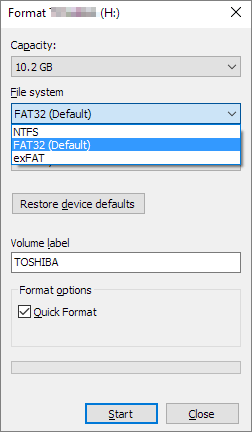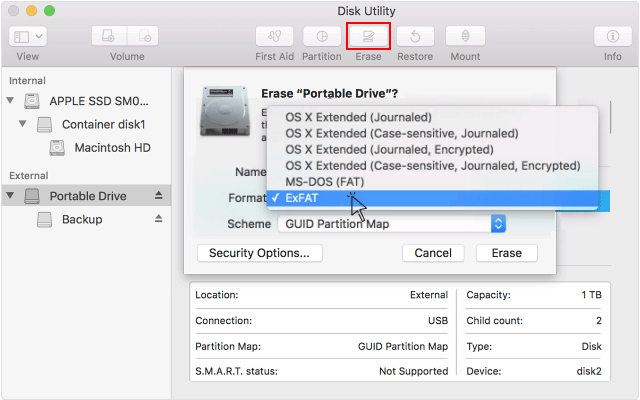

- #MAC DEFAULT FORMAT FOR USB SOFTWARE#
- #MAC DEFAULT FORMAT FOR USB DOWNLOAD#
- #MAC DEFAULT FORMAT FOR USB MAC#
You can also launch this software by using Spotlight
#MAC DEFAULT FORMAT FOR USB DOWNLOAD#
There is therefore no need to download a utility dedicated to this type of task from the internet.
#MAC DEFAULT FORMAT FOR USB MAC#
The Disk Utility that comes with your Mac computer has all the tools you need to format a removable hard drive, USB drive, or SD card. This format is also used by default on SD cards over 32 GB. Unlike FAT32, it can handle files over 4 GB. If you work simultaneously on these two types of computers (PC and Mac), it is advisable to format your USB key in ex-FAT. To put it simply, NTFS works on Windows and HFS + on Mac. Indeed some are compatible with an operating system and others not. Most of the time this is a disc format problem. Format a USB flash drive using MacOS Disk Utilityįor those of you who are used to transferring files between different devices, you have certainly noticed that some USB sticks offer lower storage capacities than those displayed by the manufacturer. In this article, we will detail the different steps required to format a USB drive from a Mac computer.


Problem, some of its storage accessories need to be formatted before they can be used to store files on them. Hopefully you now know which options above to pick from the list of best formats for external hard drives, which can save your bacon when making the wrong choice can lead to a situation where an external disk just won’t plug-and-play.Any Apple fan today has a USB stick. Picking the wrong one can turn into a real pain when you have to backup and reformat an entire drive because it won’t work for its intended purpose. Picking a format for your external drive can be pretty confusing. In fact, most devices have an internal SD card formatting routine, so we recommend you simply let the intended device format the card. exFAT is still a good choice if your DSLR (for example) supports it, but follow the manufacturer’s recommendation. With SD cards, your choice should be entirely driven by which formats the devices you use support. However, that’s set to change in the future. Of course, if you’re also going to use your thumb drive on your current Linux machine, exFAT won’t work at the time of writing. Especially if you also want to use your thumb drive with iPads, iPhones and Macs.įAT32 is a fallback if you want to use your thumb drive with older devices that don’t support exFAT. Which means you may want to use large files, such as HD video files, on your thumb drive. With the fairly cheap yet large flash drives we have today, there’s some overlap in the use cases for thumb drives and external hard drives. SD cards and USB thumb drives are still an important part of our digital lives, so which formats should you pick? The choice for the best format for external hard drives involves different considerations compared to other forms of external storage. Unfortunately, Linux does not yet have support for exFAT, but that is reportedly set to change with the release of Kernel 5.4. The most compatible option is FAT32, but as we mentioned above it has a hard 4GB limit on file sizes. However, Linux supports NTFS, which makes for a decent go-between if you have both Windows and Linux machines. Linux has its own proprietary EXT formats and if you are only going to use your external drive with a Linux machine, you can safely go ahead and pick that format. Linux distributions such as Ubuntu Linux are becoming more popular by the day, but are still relatively niche overall.


 0 kommentar(er)
0 kommentar(er)
